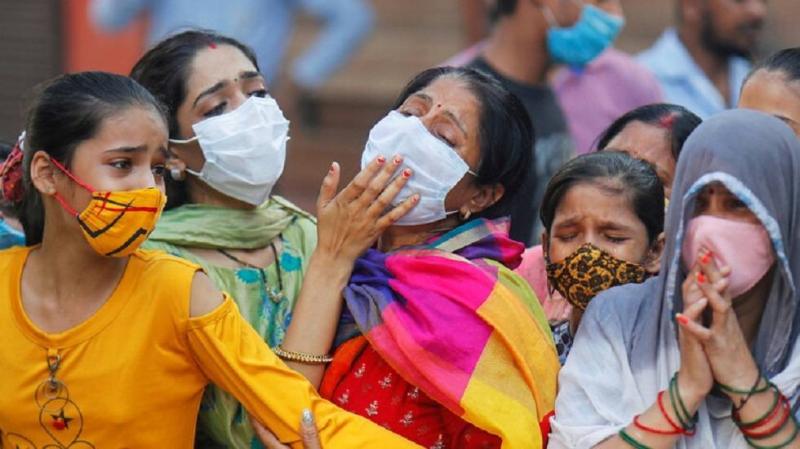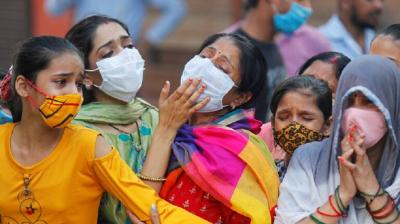India, the second most affected country by the COVID-19 pandemic in terms of cases following the United States, is facing a severe health crisis with over 2,000 deaths and more than 300,000 new infections reported in 24 hours, while struggling with a shortage of treatments and oxygen. The death toll in the second most populous country has surpassed 182,000 due to COVID-19, with infections totaling 15.9 million. Since the World Health Organization reported the emergence of the disease in China at the end of December 2019, COVID-19 has caused 3,046,134 deaths worldwide, according to a count conducted by AFP based on official sources as of Wednesday at 10:00 UTC. More than 142,838,730 individuals have been confirmed infected with the virus since its emergence. The vast majority of those infected have recovered, although some continue to experience symptoms weeks or even months later. Some individuals may be at higher risk for severe illness due to underlying characteristics or medical conditions, as reported by a study published on Boldsky, a health-related site. Recent reports indicate that India is witnessing the largest surge since the outbreak of the pandemic. Meanwhile, a new variant of the SARS-CoV-2 virus has been identified in India, designated B.1.618, which is primarily spreading in West Bengal.
### The Triple Mutation
Following the emergence of the double mutation of the novel coronavirus, a triple mutation has now appeared; three different strains of SARS-CoV-2 have been discovered jointly forming a new variant in parts of India. It is believed that cases in Maharashtra, Delhi, Chhattisgarh, and West Bengal are caused by this triple mutation. Professor Vinod Scaria, a scientist at the CSIR-IGIB genomic and integrative biology institute in New Delhi, tweeted a thread detailing the discovery of a new mutated coronavirus characterized by a set of genes and immunological traits, known as escape variants, which have the ability to resist antibodies acquired after vaccination. The initial sequences of the B.1.618 variant were found in West Bengal. The first sequence of this lineage was isolated on October 10 of last year from a patient in West Bengal. While this lineage is primarily found in India, variants have also been detected in the United States, Switzerland, Finland, and Singapore.
### Higher Infectivity
Experts believe that these mutations are contributing to rising rates of new infections globally. However, more studies are required to fully understand the mutated strains. Currently, only ten laboratories across India are involved in genomic studies of the triple mutation of the virus.
### Vaccine Impact
Scientists currently cannot confirm whether the new variant has the potential to cause reinfection and evade the immune response of vaccinated individuals, as they still need additional experimental data. It has been noted that two of the three variants in the triple mutation exhibit immune escape responses, indicating they are more resistant to antibodies. Researchers suggest that the new variant may also have some capacity to evade immunity gained from natural COVID-19 infection. According to researchers, vaccines should continue to be "modified in light of further understanding of the virus and its mutated strains."
### Cause of Mutation
Studies indicate that the more the virus spreads, the more it multiplies and mutates. Amid the massive surge in COVID-19 cases in the country, there is considerable concern regarding the severity of symptoms during the second wave of the pandemic. According to experts, the differences in symptom severity seen during the second wave are much lower than last year, considering some key points:
- Symptoms are less severe in the second wave.
- More cases of breathlessness have been reported in the second wave, while previous symptoms included dry cough, joint pain, and headaches.
- There has only been a marginally high percentage of young COVID-19 patients; the average age of patients in the first wave was 50 years, while in the latest wave, it was 49 years — indicating that older populations are still more at risk.
- There is no difference in mortality rates between the first and second waves.
### Vaccination with Symptoms
As vaccination campaigns ramp up, with individuals aged 18 and older eligible for vaccination starting May 1, many wondered whether it is safe to get vaccinated while exhibiting COVID-19 symptoms or if it would affect the vaccine's efficacy. According to experts, the following steps should be taken regarding vaccination if the recipient shows COVID-19 symptoms:
- The vaccination appointment should be postponed if the recipient has symptoms.
- If symptoms suggest COVID-19, the second dose can be delayed for a few weeks to see how things develop.
- Even if symptoms are mild, vaccination should be postponed.
- Receiving a vaccine while a continuous infection is present can be extremely harmful.
- Studies indicate that delaying the vaccine when showing COVID-19 symptoms is preferable, as the immune response proves better if vaccination is postponed for up to 12 weeks.
### Critical Signs and Symptoms
COVID-19 symptoms can rapidly deteriorate from mild to severe. The first week of infection is critical as the viral load peaks. Those infected should be vigilant and closely aware of symptoms. Scientists delineate certain signs indicating the need for hospital transfer:
- Breathlessness and chest pain can be signs of worsening infection.
- A decrease in blood oxygen levels.
- Any episodes of delirium or feelings of confusion.
- Chest pain.
- Blue lips (typically due to decreased oxygen levels).
- Urinary tract infections (which emerged during this second wave).
In addition to these symptoms, experts recommend contacting emergency services or heading to the hospital immediately if any existing symptoms worsen or new symptoms such as fever, diarrhea, fatigue, or decreased oxygen levels appear.




